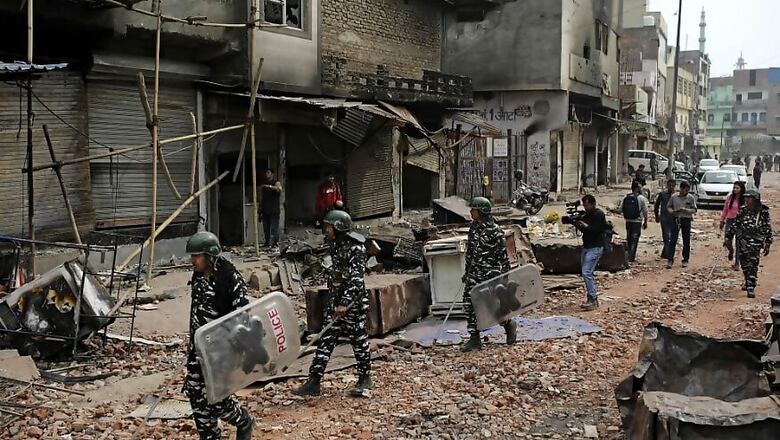
views
As one approaches Delhi from the north, the first major landscape which attracts attention on entering the national capital is the garbage mount at the Mukarba Chowk.
Once a busy crossroad leading to jams, movement here is now relatively free thanks to the grade separators built during the Commonwealth Games. On taking a left turn from Mukarba Chowk and driving down the road, one approaches the sleekly built Signature Bridge.
Built around eight years ago and made operational only two years ago, the Signature Bridge is the gateway to north-east Delhi, the epicentre of the recent Hindu-Muslim conflagration. Parallel to the Signature Bridge still exists the Old Wazirabad Bridge, and the road leading into this portion of the sprawling trans-Yamuna area is called the Wazirabad Road.
This arterial road today, largely thanks to the development agenda pursued by the Sheila Dikshit government, is six-lane replete with flyovers though certain bottlenecks still exist. As one takes the road from the bridge to the Uttar Pradesh border near Hindon Air Terminal, a picture of skewed development is writ large.
Unlike such bridges in the other global cities, the Signature Bridge of Delhi takes the traveller to city’s underbelly. During the 10-km long drive on the road, except for Yamuna Vihar, it’s difficult to locate any planned colony.
The densely populated area has ghetto-like habitations either in the urbanized villages or the unauthorized colonies built on the agriculture holdings belonging to these villages.
Thus the now (in)famous localities of Chandbagh, Khajuri, Ghonda, Bhajanpura, Jaffarabad, Shiv Vihar and Ashok Nagar among others have no umbilical cord attached to the Delhi Development Authority (DDA), the body responsible for the development of the city.
The rise of the area can be traced to the beginning of the 1980s, when governance started to fail the north Indian states, particularly those of Uttar Pradesh and Bihar. Migration started from these states to the national capital in search of hearth and home.
Though trans-Yamuna became the new destination for those looking homes, the relatively wealthier population preferred residences in close proximity of the old business hub of Shahdra.
The middle class chose to make home further south in the DDA townships of Indraprastha Extension (Patparganj) and Mayur Vihar. It was the poorest of the lot who found home in the northernmost part of east Delhi; thus the rise of the unplanned notorious neighbourhood of north-east Delhi. Development for long remained a concept alien to the residents here as the more pressing question was of survival.
The rise of these settlements was also spurred by the dynamics of vote bank politics patronized by then Delhi Congress strongman Har Kishan Lal Bhagat. Most of the habitations here have been sired by Bhagat or his acolytes like Rambabu Sharma, another prominent Delhi Congress leader.
Lack of development, employment and education breeds anger which bursts in various forms, including communal conflagrations, burning down of shops, houses and worse, schools. This is not the first time that north-east Delhi witnessed communal riots.
Communal tension always prevailed in these areas and they turned violent at times, like the 1992 flare-up following the demolition of Babri Masjid. The matter was not allowed to go out of the hands as then existed a more decisive Delhi Police leadership, which did not work only to address the concerns of the political leadership.
The 1992 flare-up was not an isolated incident. The Ram Janmabhoomi movement had good influence in the area and during the 1991 Lok Sabha polls, it saw the mobilisation of Hindu votes in favour of BJP candidate Baikunthlal Sharma Prem, who won the East Delhi seat.
A Vishwa Hindu Parishad functionary, Sharma retained the seat in 1996 and thereafter it remained with the BJP till 2004, when then chief minister Sheila Dikshit’s son Sandeep Dikshit was elected.
Post delimitation in 2009, a new parliamentary seat was created — North-East Delhi, which had a large Muslim population. Though it was won by the Congress in 2009, in 2014 and 2019 it again went to the BJP. In fact, in the just concluded assembly elections, of the eight seats won by the BJP from across the city, three are from north-east Delhi and another three from the neighbouring east Delhi parliamentary constituencies.
The last assembly elections also saw a complete collapse of the Congress party machinery in the area. With known faces from the minority community like Chaudhary Mateen Ahmed and Hasan Ahmed no further enjoying electoral legitimacy, there was none to provide counsel for patience and peace in the face of provocation on the issue of Citizenship Amendment Act.
The Aam Aadmi Party (AAP) may have usurped the Congress votes lock, stock and barrel in these areas, but it has failed to create a leadership infrastructure among the minority community. Today AAP councillor Tahir Hussain has become the face of the riot and the leadership was forced to suspend him.
The absence of any initiative by the newly elected government to arrest the raging riots made the minority community as well as the majority community pay a very heavy price for the lure of the supply of free power and water to these ghettos, where milling crowd live. The riots have negated the recent definition of development in terms of B-S-P that is Bijli (power), Sadak (roads) and Paani (water).
North-East Delhi has all the three elements in plenty but still savagery ruled the area. Is governance just about sloganeering and winning elections or also providing public safety. It’s a question which for long has remained unanswered especially in matters of governance of Delhi.
(The writer is a senior journalist and political analyst. Views are personal)




















Comments
0 comment